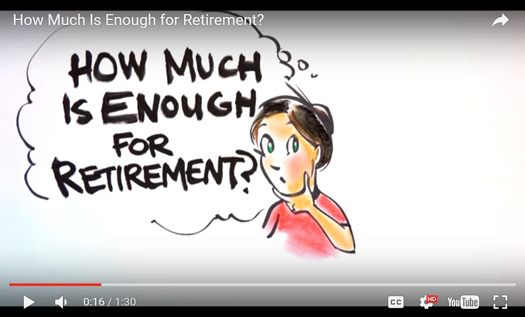How to Start Saving Later in Life

Funny how life sneaks up on us. One day, we’re starting a new job, spending a little extra money, and thoroughly enjoying life … ah, immediate gratification … and the next, we realize we’re approaching or at retirement age, and our bank accounts and investments look dismal. Now what?!
“Retirement” may not be possible for everyone, at least not in the traditional sense of living a life filled with both leisure time and creature comforts. The 16th Annual Transamerica Retirement Survey—A Compendium of Findings About American Workers includes these facts:
- Only 59 percent of the current workforce is “somewhat” or “very” confident that they will have enough to fully retire in comfort.
- Fifty-four percent of workers believe they will need to save $1 million or more by the time they retire in order to be financially secure. Nine percent estimated they would need less than $100,000 for retirement. The estimated median retirement savings among workers is $63,000.
- Forty-four percent of workers fear that they will outlive their savings and investments. Long-term care, reductions in Social Security, and health care costs are also concerns.
- Twenty-eight percent of workers do not currently receive retirement benefits from their employer.
- Fifty-eight percent of workers save for retirement outside of work.
- Only 45 percent of workers consider their employer to be “aging friendly” and 23 percent feel their employers are not age-friendly.
Here’s another scary thought: Fidelity Investments estimates that, on average, a couple that retires together at age 65 and experiences average life expectancy (85 for a male, 87 for a female) can expect to spend $245,000 on health care throughout retirement. Health status, geographic area, and longevity can influence the actual cost.
Another study (Goda & Sojourner, 2015) found that those who don’t save well face two kinds of challenges—procrastination (closely related to the desire for immediate gratification) and underestimating the power of compound interest (when your interest earned earns interest over time). This article addresses the first challenge—procrastination—in the hope that basic goals for later life can still be met.
Develop a plan and pay yourself first
Most people have heard the secret to avoiding procrastination—make a plan, and then break it down into smaller parts. How do you want to live in the future? The Consumer Financial Protection Bureau (CFPB) goal-setting tool asks about your hopes, wants, and dreams. Think about your future and what makes the most sense for you. You are worth it.
Once you know your short- and long-term goals, consider what you need in your rainy day fund, and set up your savings plan and a budget. The National Council on Aging offers an easy online tool called Figure Out a Budget in 3 Minutes.
The CFPB provides a wealth of additional resources, including a financial empowerment toolkit for workers and tips that older adults (and others) can use to protect their assets (here).
Improve cashflow
You may think this isn’t possible, but even if you live on a low fixed income, there are strategies you can consider. If you still work, you can take steps to improve your cashflow and put more money into savings.
Note the strategies for reducing your heating and energy costs. Low-income households in Seattle and King County have several energy assistance programs available that can save money (often upwards of $1,000 each year). Save that money, if you can, or use it to avoid interest charges elsewhere.
The Financial Empowerment Network of Seattle-King County offers a long list of other community resources that can lead to financial savings.
If you haven’t already done so, spend some time with these online tools:
If you have questions about benefits, call Community Living Connections, a local network that helps adults facing aging and disability issues get the information and support they need to make informed decisions, at 206-962-8467 (toll-free 1-844-348-5464).

Washington State Department of Financial Institutions and KCTS9 say it’s never too early—or too late—to start saving for retirement … but how much is enough? Click on the image above to watch the video. Visit KCTS9 Cash with Draw for more financial education videos.
Feds offer savings incentives
If you’re still working, the Internal Revenue Service (IRS) offers several incentives for saving:
- The Saver’s Credit is available to individuals and households that meet certain income requirements for making contributions to an IRA or a company-sponsored retirement plan such as a 401(k) plan or 403(b) plan.
- People age 50 and older may be allowed to make catch-up contributions of up to $6,000 to their 401(k)/403(b)/457(b) plan or IRA (over and above their plan- or IRA-contribution limit).
- The Earned Income Tax Credit (EITC) is a benefit for working people with low to moderate income. See if you qualify at www.irs.gov/EITC.
The U.S. Treasury Department now offers MyRA—a Roth IRA for people who don’t have a retirement savings plan. You can set up automatic direct deposit contributions through an employer or from a checking or savings account. At tax time, you can direct all or a portion of your federal income tax return to go to myRA.
Please read the online tax information carefully. You may wish to consult a financial advisor.
Need help preparing your taxes? United Way of King County, which provides free tax help at dozens of tax prep sites across King County during tax season, may be able to help.
Online banking
Online banking can save time and money (for instance, quick fund transfer to avoid fees). Uneasy? The National Council on Aging offers Ready, Set, Bank™, a series of videos—tested with older adults—that cover everything from how to make a mobile deposit to how to check your balance and pay bills.
Procrastinators, set your savings goals and put your plan in motion today. Every extra dollar will help you have more choices and a better life in the future.
Aging and Disability Services planner and AgeWise King County editor Irene Stewart compiled these resources. She readily admits the need to save more of her own hard-earned money because retirement doesn’t look feasible for quite some time.
Special thanks to Dana Twight, Twight Financial Education, for her review and recommendations.
![AgeWise King County [logo]](https://www.agewisekingcounty.org/wp-content/themes/agewisekingcounty/images/logo.png)